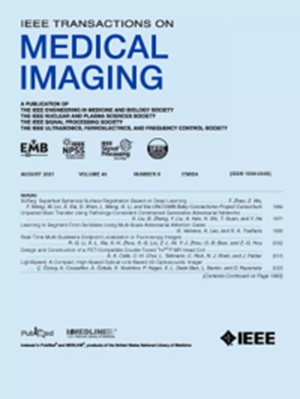Enhancing Brain Source Reconstruction by Initializing 3D Neural Networks with Physical Inverse Solutions.
IF 9.8
1区 医学
Q1 COMPUTER SCIENCE, INTERDISCIPLINARY APPLICATIONS
引用次数: 0
Abstract
Reconstructing brain sources is a fundamental challenge in neuroscience, crucial for understanding brain function and dysfunction. Electroencephalography (EEG) signals have a high temporal resolution. However, identifying the correct spatial location of brain sources from these signals remains difficult due to the ill-posed structure of the problem. Traditional methods predominantly rely on manually crafted priors, missing the flexibility of data-driven learning, while recent deep learning approaches focus on end-to-end learning, typically using the physical information of the forward model only for generating training data. We propose the novel hybrid method 3D-PIUNet for EEG source localization that effectively integrates the strengths of traditional and deep learning techniques. 3D-PIUNet starts from an initial physics-informed estimate by using the pseudo inverse to map from measurements to source space. Secondly, by viewing the brain as a 3D volume, we use a 3D convolutional U-Net to capture spatial dependencies and refine the solution according to the learned data prior. Training the model relies on simulated pseudo-realistic brain source data, covering different source distributions. Trained on this data, our model significantly improves spatial accuracy, demonstrating superior performance over both traditional and end-to-end data-driven methods. Additionally, we validate our findings with real EEG data from a visual task, where 3D-PIUNet successfully identifies the visual cortex and reconstructs the expected temporal behavior, thereby showcasing its practical applicability.用物理逆解初始化三维神经网络增强脑源重构。
重建脑源是神经科学的一个基本挑战,对理解脑功能和功能障碍至关重要。脑电图(EEG)信号具有很高的时间分辨率。然而,由于问题的病态结构,从这些信号中确定大脑源的正确空间位置仍然很困难。传统方法主要依赖于手工制作先验,缺乏数据驱动学习的灵活性,而最近的深度学习方法侧重于端到端学习,通常使用前向模型的物理信息仅用于生成训练数据。提出了一种新的脑电信号源定位混合方法3D-PIUNet,该方法有效地融合了传统和深度学习技术的优点。3D-PIUNet通过使用伪逆从测量值映射到源空间,从初始物理信息估计开始。其次,通过将大脑视为一个三维体积,我们使用三维卷积U-Net捕获空间依赖关系,并根据事先学习的数据改进解决方案。训练模型依赖于模拟的伪真实脑源数据,覆盖不同的源分布。在这些数据的训练下,我们的模型显著提高了空间精度,表现出优于传统和端到端数据驱动方法的性能。此外,我们用视觉任务的真实脑电图数据验证了我们的发现,其中3D-PIUNet成功地识别了视觉皮层并重建了预期的时间行为,从而展示了其实用性。
本文章由计算机程序翻译,如有差异,请以英文原文为准。
求助全文
约1分钟内获得全文
求助全文
来源期刊

IEEE Transactions on Medical Imaging
医学-成像科学与照相技术
CiteScore
21.80
自引率
5.70%
发文量
637
审稿时长
5.6 months
期刊介绍:
The IEEE Transactions on Medical Imaging (T-MI) is a journal that welcomes the submission of manuscripts focusing on various aspects of medical imaging. The journal encourages the exploration of body structure, morphology, and function through different imaging techniques, including ultrasound, X-rays, magnetic resonance, radionuclides, microwaves, and optical methods. It also promotes contributions related to cell and molecular imaging, as well as all forms of microscopy.
T-MI publishes original research papers that cover a wide range of topics, including but not limited to novel acquisition techniques, medical image processing and analysis, visualization and performance, pattern recognition, machine learning, and other related methods. The journal particularly encourages highly technical studies that offer new perspectives. By emphasizing the unification of medicine, biology, and imaging, T-MI seeks to bridge the gap between instrumentation, hardware, software, mathematics, physics, biology, and medicine by introducing new analysis methods.
While the journal welcomes strong application papers that describe novel methods, it directs papers that focus solely on important applications using medically adopted or well-established methods without significant innovation in methodology to other journals. T-MI is indexed in Pubmed® and Medline®, which are products of the United States National Library of Medicine.
 求助内容:
求助内容: 应助结果提醒方式:
应助结果提醒方式:


